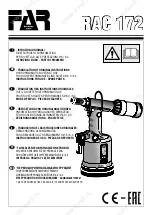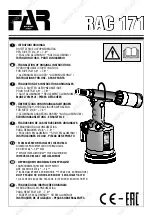
INSTRUCTIONS Wood's Models
W4950WBP
W5450WBP
W6450WBP
W6100WBP
Rev. 0.4 / 01-21 Instruction Sheet 32640AMCRL LVAA
Glazing, Industrial, Construction
Architectural and Automotive Supplies
Phone Toll Free (800) 421-6144
Fax Toll Free (800) 262-3299
CORPORATE HEADQUARTERS
P.O. BOX 58923, LOS ANGELES, CA 90058-0923
Serving the Industries Worldwide
www.crlaurence.com
SPECIFICATIONS
Product Description
Hand cups use vacuum to lift and carry loads, as follows: A manual pump
removes air from between the rubber pad and the contact surface; an audio
alarm and a red line on the pump's plunger serve as low vacuum indicators;
a check valve allows the user to repump the cup without removing it from
the contact surface; and a release mechanism allows the cup to disengage
completely.
Model
Pad
Nominal Dia.
Max. Load Capacity*
W6100WBP
LJ6
6" [15 cm]
70 lbs [32 kg]
W4950WBP
VPFS8L
8" [20 cm]
125 lbs [57 kg]
W5450WBP
G0725
9" [23 cm]
150 lbs [68 kg]
W6450WBP
G0750
10" [25 cm]
175 lbs [79 kg]
*Maximum Load Capacity includes a 3:1 safety factor and requires the
following: attachment on clean, smooth, nonporous flat surfaces; a minimum
vacuum level of 17½" Hg [-59 kPa]; and a friction coefficient of 1. This rating
is based on tests of new hand cups attached to the upper, horizontal surface
of static objects in ideal conditions. Many factors can reduce the capacity,
including: lifting a load when the cup is attached to a vertical or inclined
surface; or lifting a load that applies leverage to the cup. See
crlaurence.com
for more information.
Low Vacuum Audio Alarm
Volume: 70 dBA at 36" [91 cm]
Power Source: one AAA size, 1.2-1.5-volt alkaline battery; automatic on/off
function
Load and Environmental Conditions
Use the cup on clean, relatively smooth, nonporous surfaces, at temperatures
from 10° to 120° F [-12° to 49° C] and elevation up to 5,000' [1,524 m]. Moisture
or contaminants can reduce the slip resistance of the cup. Excessive exposure to
moisture can also damage the audio alarm or reduce its life. Contact an authorized
dealer or visit
crlaurence.com
for more information.
OPERATION
To Test Audio Alarm
Prior to using the hand cup, make sure the audio alarm is functioning
correctly and can be heard clearly over ambient sound in the work
environment: While leaving the sound emission holes uncovered,
depress the plunger slightly. The audio alarm should sound; if not, see
MAINTENANCE: Service.
To Attach Hand Cup
1) Position the cup on the contact surface so the red line will be visible if it
should appear while lifting the load. CAUTION: Test the cup for staining
or deformation of load surfaces with light colors or soft coatings.
2) Pump the plunger until the cup attaches completely. When the red line
is hidden and the audio alarm is silent, vacuum is sufficient for lifting.
3) Check the plunger frequently to make sure the cup remains securely
attached. If the red line appears or the audio alarm sounds while lifting,
set down the load immediately and pump the plunger until the red line
is hidden and the audio alarm is silent again (see WARNINGS).
To Release Hand Cup
1) Set the load on a secure support.
2) Pull one of the release tabs (on 6" [153 mm] cups) or press the valve
release lever (on other cups) until the cup disengages completely.
CAUTION: Remove the cup when not in use.
MAINTENANCE
Service
Since aging and wear reduce the capacity of the rubber pad, it should be
replaced at least once every 2 years or whenever damage is discovered (see
Inspection).
If the audio alarm does not function normally (see OPERATION), make
sure a working battery is installed correctly (see TO REPLACE BATTERY,
overleaf). If the condition persists, contact an authorized dealer or visit
crlaurence.com
for assistance.
If the hand cup does not function normally, the cup face may be dirty or the
cup may require service. First clean the cup face according to the directions
to follow. If the condition persists, contact an authorized dealer or visit
crlaurence.com
for assistance.
Cleaning
1) Remove the air filter from the cup face.
2) Use a clean sponge or lint-free cloth to apply soapy water or another
mild cleanser to the cup face; see WARNINGS and crlaurence.com for
more information. CAUTION: To prevent liquid from contaminating the
pump, hold the cup face-down or cover the suction hole in the filter recess.
3) Wipe all residue from the cup face.
4) Allow the cup to dry and reinstall the air filter.
Inspection
Examine and test the cup regularly to make sure it does not exhibit the
following faults:
• failure of audio alarm to function correctly (see OPERATION).
• corrosion or other indications of battery leakage inside battery
chamber (see TO REPLACE BATTERY, overleaf).
• cuts or damage to sealing edges of rubber pad.
• cracks or dents in handle or pump.
• reappearance of red line soon after attaching cup.
• sluggishness or dramatic changes in pump action.
• excessive glaze or stiffness of rubber pad.
• air filter missing from cup face.
Correct any faults before using the cup (see Service).
Storage
Store the cup in clean, dry condition within its protective carrying case. If
the cup is used once a month or less often, remove the battery (see TO
REPLACE BATTERY, overleaf) and store it separately, to prevent corrosion.
WARNINGS
Failure to observe WARNINGS could damage the hand cup or the load, or
cause injury to the user.
• Do not use the cup to lift loads that exceed the Maximum Load Capacity
or the effective capacity (see SPECIFICATIONS).
• Do not use the cup to support a person.
• Do not place the cup face against surfaces which could damage the
sealing edges.
• Avoid conditions that could cause the cup to slip or to disengage
prematurely, such as: contaminants, cuts or scratches in the cup face or
contact surface; applying the cup to porous materials; or applying
pressure against the cup edge.
• Do not use the cup to lift when the red line is visible or the audio
alarm is sounding. If the red line reappears or the audio alarm
sounds frequently, discontinue use and see MAINTENANCE: Service.
• Do not allow anything to interfere with free movement of the plunger while
the cup is attached.
• Do not touch the release tabs (on 6" [153 mm] cups) or the valve release
lever (on other cups) while lifting.
• Do not attach 10" [254 mm] diameter cups to thin, fragile materials.
• Do not use harsh chemicals (such as solvents or gasoline) or unauthorized
rubber cleaners and conditioners to clean the cup.
• Avoid contact with battery leaks because they contain chemicals that could
damage eyes, skin, clothing or the plunger assembly.
• Do not expose a battery to excessive heat (see SPECIFICATIONS:
Environmental Conditions), because this could cause the battery to
explode.


























